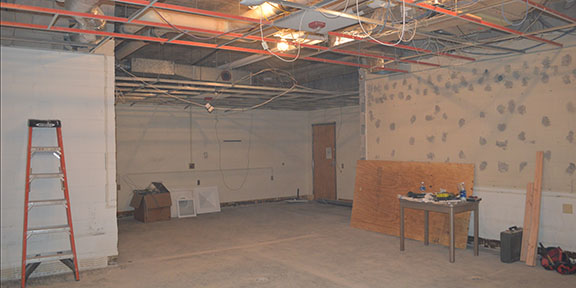IMAGE OF THE WEEK

One of several renovation projects happening in Walker Building this summer and fall. Here, room 229 is being transformed into The C. Gregory Knight Collaborative Learning Lab.
GOOD NEWS
David G. Lautenschleger (’14g) has been recently hired as a full-time assistant professor at the University of Akron in the College of Applied Science and Technology. He will be teaching Surveying and GIS courses.
Azita Ranjbar is a co-author along with Gines, K., O’Brian, E., Ewara, E., Paris, W. (forthcoming).of Teaching Philosophical “Special” Topics: Black Feminism and Intersectionality. In O. Perlow (Ed.) Black Women’s Pedagogy and Praxes.
Yanan Xin earned travel rewards for CyberGIS’16 conference and presented poster for research project “using volunteered geographic information to estimate people’s accumulated radiation exposure.”
Send your good news to geography@psu.edu to be announced during Coffee Hour and published here.
NEWS
Department Newsletter Published
The Summer 2016 Department of Geography annual newsletter, GEOGRAPH, has been mailed and is now available online.
GEOGRAPH highlight
From the Department Head: Poised for success
We are getting a jump on the university-level revamp of general education requirements and Penn State’s new emphasis on engaged scholarship: out-of-class experiences that complement in-class learning, such as undergraduate research, internships, study abroad, service learning and community-based learning. Our UROC program that pairs undergrads with grad thesis research work (Geog 494) is a successful aspect of research engagement for geography majors. We are also poised to offer some of the first gen eds categorized as meeting the new Integrative Studies (IS) requirement. All Penn State general education courses will be re-certified this year, and we are ready. Brent Yarnal, whose retirement is celebrated in this issue, was a leader in both these initiatives at the university level as past Senate chair.
We are getting a jump on the university-level revamp of general education requirements and Penn State’s new emphasis on engaged scholarship: out-of-class experiences that complement in-class learning, such as undergraduate research, internships, study abroad, service learning and community-based learning. Our UROC program that pairs undergrads with grad thesis research work (Geog 494) is a successful aspect of research engagement for geography majors. We are also poised to offer some of the first gen eds categorized as meeting the new Integrative Studies (IS) requirement. All Penn State general education courses will be re-certified this year, and we are ready. Brent Yarnal, whose retirement is celebrated in this issue, was a leader in both these initiatives at the university level as past Senate chair.
GEOGRAPH highlight
Mapping refugees through online engaged scholarship
This summer, Penn State Department of Geography online geospatial education program instructors Beth King and Fritz Kessler took ten students in the online Master of Geographic Information Systems (MGIS) program on a unique travel experience. In the new course, GEOG 597G: Challenges in Global Geosptial Analytics, Penn State students collaborated with graduate students from ITC – University of Twente located in Enschede, Netherlands to develop solutions to analyze spatio-temporal patterns in refugee migration data.
“The current refugee crisis is unprecedented and has implications for mass migration, humanitarian aid, resettlement, and it affects nations world-wide. Our students developed visualization solutions using the United Nations High Commission for Refugees (UNHCR) database to provide assistance to refugees,” King said. The solutions entailed developing software, identifying potential funding sources, and making recommendations on how best to allocate resources to benefit refugees.
RECENTLY (OR SOON TO BE) PUBLISHED
Measuring Spatial Accessibility to Urban Facilities and Services in Tehran
By Rabiei-Dastjerdi, H., Matthews, S. A. & Ardalan, A.
In Spatial Demography (2016).
doi:10.1007/s40980-016-0028-2
During the last quarter century the developing world has been experiencing rapid urban growth. These rapidly changing urban landscapes can create many new opportunities for economic growth but the same processes can also generate spatial inequalities within urban boundaries. Using recent and comprehensive geospatial data we describe, map and examine one dimension of urban spatial inequality, our results suggest that accessiblity to urban facilities and services. Our case study is Tehran; one of the most rapidly growing cities in the Middle East and he developing world. Geospatial data, Geographic Information Systems and spatial analytical tools were combined for mapping accessibility to thirty different urban facilities and services in Tehran. Descriptive maps identify areas of under and over services.
Impact assessment of PM10 cement plants emissions on urban air quality using the SCIPUFF dispersion model
By Vincenzo Leone, Guido Cervone, Pasquale Iovino
In Environmental Monitoring and Assessment
doi: 10.1007/s10661-016-5519-5
The Second-order Closure Integrated Puff (SCIPUFF) model was used to study the impact on urban air quality caused by two cement plants emissions located near the city of Caserta, Italy, during the entire year of 2015. The simulated and observed PM10 concentrations were compared using three monitoring stations located in urban and sub-urban area of Caserta city. Both simulated and observed concentrations are shown to be highest in winter, lower in autumn and spring and lowest in summer. Model results generally follow the pattern of the observed concentrations but have a systematic under-prediction of the concentration values. Measures of the bias, NMSE and RMSE indicate a good correlation between observed and estimated values. The SCIPUFF model data analysis suggest that the cement plants are major sources for the measured PM10 values and are responsible for the deterioration of the urban air quality in the city of Caserta.
